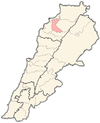Ehden
[2] This view is supported by Anis Freiha who writes:The name of Ehden comes from Adon, Adonis meaning "power, stability and tranquillity".
[3]Patriarch Estephan El Douaihy,[4] along with Father Martens the Jesuit, lean toward the conclusion that Ehden’s name is derived from Eden where Adam and Eve lived following their exit from paradise.
[6] Ehden is located in the central northern side of Mount Lebanon, with a 1500-metre (at Midan square) elevation from sea level.
Its indigenous people transformed rocky hills into land suitable for crops, irrigated by water from mountain streams.
Despite the changes that have taken place over the centuries, Ehden's people have maintained their strong ties to their cultural heritage and history.
The town continues to be a vibrant hub of creativity, thought, and spirituality, making it an important destination for anyone interested in Lebanon's rich cultural heritage.
Some early texts mention that the people of Ehden are descendants of the tribe of Shem, the son of Noah.
[8] - 850 BCE: the Aramean king Hadadezer came to Ehden and rebuilt it, hoisting a statue of its god known then as “Baal Loubnan” or “The God of Snow”[citation needed] - 700 BCE: Sennacherib, the Assyrian king through his leading assistant Rabshakeh, occupied Ehden and destroyed it by setting it alight and overturning its statue.
Seleucus I also built a large pagan temple on the eastern side where he erected a statue of the Sun-god Helios.
A brief account of Ehden's history has been found written by one of its inhabitants who fled from the Mamluk invasion in 1283, tying the manuscript to his chest for safekeeping.
Father George Yammine found the manuscript, which was written on an old piece of leather, at the start of the 19th century in a priest's home in Bsharri.
Huge rocks that have remained scattered on mountaintops, as well as large stones used in building some of its churches, still leave indication of that era.
Father La Monse the Jesuit stated that there are three scriptures in Mar Mama church, two are written in Greek and another in Syriac.
As for the Syriac writing, “Rinan” translated the remainder of its meaning in his book titled “Phoenician Mission” as follows: “In the name of God who is capable of resurrecting the dead.
Marcos had lived and died.”There is also a historical writing, which was transferred to France and is preserved in its Paris museum in the Orient section, numbered 4524 and dated 272 AD.
Dr. Philip Hitti in his book Lebanon in History affirms that “Ruins dating back to the era of the Roman Empire are widely spread over the mountains.
Statues carved on rocks, in addition to Greek and Roman sculptures, graves, temple ruins and buried columns were found in branched and distant villages like Chouslan, Kartaba, Akoura, Tanourin and Ehden.” Ehden’s most famous Christian site is “Dayr al-Salib” (Convent of the Cross), which is a symbol of an era of transformation for Ehdenians who had turned away from idolatry and converted to Christianity, according to a historical document written by Father Kozma.
Nevertheless, Al-Semaani wrote in his book The Eastern Library that he witnessed those cross-engraved stones in Hassroun, Bsharri, Ehden and Aytou.
Afka is the first holy city in history according to Father Dr. Youssef Yammine al-Ehdeni who is trying to prove this theory by embarking on historical research he has not as yet completed.
Ehden is a beautiful city renowned for its healthy environment, moderate dry climate and natural fresh water.
Many cafés can be found in “Al-Moghtaribin” (Immigrants) Street and “Al-Mattal” area, creating an atmosphere of celebration lasting all over Ehden summer attracting tourists and visitors from Lebanon and the world.
Ehden has experienced a building boom in recent times extending beyond its traditional precincts where modern villas and apartments were built.
A large pagan temple was built by Seleucus a commander in Alexander the Great’s army and raised a statue of "The god of Sun" nearby.
The forest embraces a vital natural forestry reserve with a variety of 40 different types of native plants such as cedars, fir, pine, elm and many others.








